Excerpts from Jim Conrad's
NATURALIST Newsletter
from the July 16, 2017 Newsletter issued from Rancho Regenesis in the woods ±4kms west of Ek Balam Ruins; elevation ~40m (~130 ft), N20.876°, W88.170°; north-central Yucatán, MÉXICO
ROADSIDE GIANT TOAD
Last Sunday on my banana-buying biking trip to Temozón, at the edge of the highway's pavement and sheltering in the shade of overhanging grass, there was the huge, yellowish toad shown below:
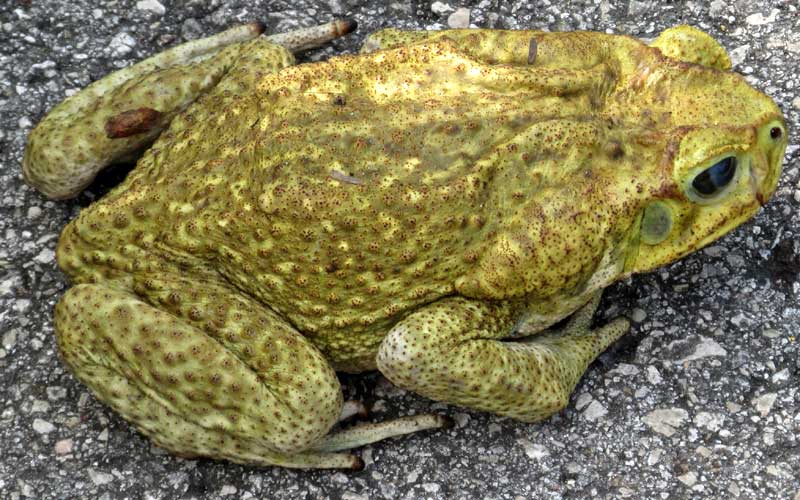
Different toad species occur in the Yucatan, but from the first it was apparent that this was the Giant Toad, also called the Cane Toad, traditionally designated BUFO MARINUS* but nowadays often shifted to its own genus and named Rhinella marina.
"Rhinella horribilis is the scientific name used for populations of the cane toad or giant toad located in Mesoamerica and north-western South America when they are considered to be a separate species from Rhinella marina, a name which is then mostly restricted to Amazon basin populations. R. horribilis was originally described from Mexico as Bufo horribilis before later being considered a synonym of Bufo marina and later Rhinella marina. The specific epithet horribilis has now been revived after a 2016 study argued that these populations in fact make up two separate species.
It was clearly a Giant Toad because of its size, which you can judge better in the picture below of him being held in my hand:
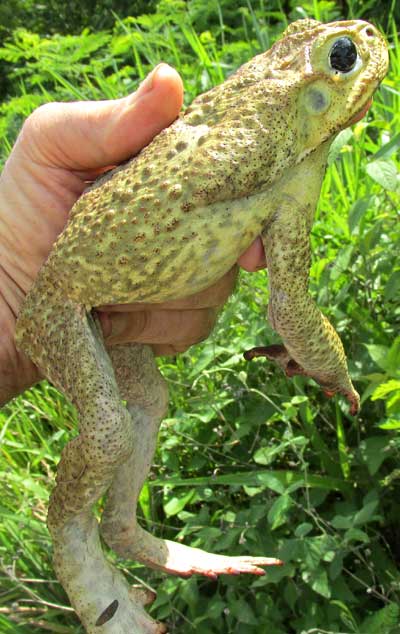
In Mexico and North America, there's simply no other toad even approaching being this large.
The toad made no effort to hop away, and when I picked him up he didn't struggle or seem concerned at all. Maybe he'd been stunned by an encounter with a car, though no signs of injury were visible. While I had such a cooperative subject, I took several pictures, including one meant to show the big parotoid gland, which looks like a bean bulging from beneath the skin in the lower, left corner of the picture shown below:
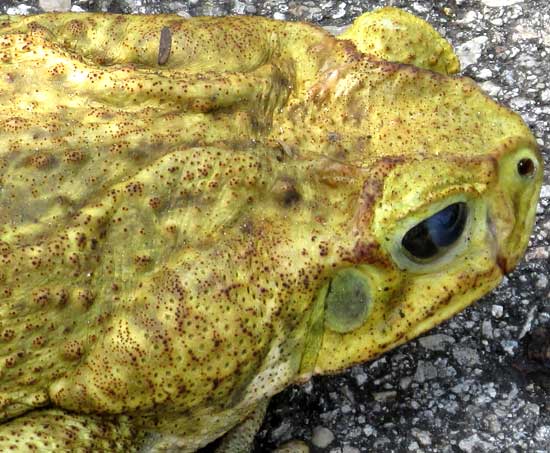
Just last week, showing how to distinguish between an immature Giant Toad and our abundant Gulf Coast Toads, a similar picture was provided emphasizing the Gulf Coast Toad's much relatively small parotoid gland, which you can review at www.backyardnature.net/n/17/170709gt.jpg
In that picture, notice how the Gulf Coast Toad's parotoid is about the same size as its eardrum, or "tympanic membrane" behind the eye, while our Giant Toad's parotoid is much larger, as well as shaped different.
I was fascinated by our Giant Toad's front foot, shown below:
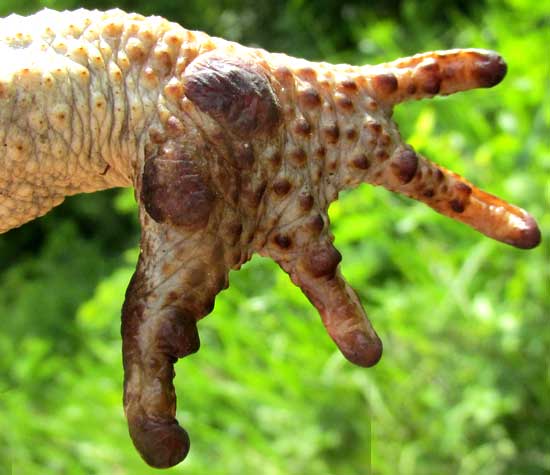
When I positioned the toad in sunlight for a view of the head, his eyelid-like "nictitating membrane" slid up over the eye, apparently in response to the bright light, as seen below:

Nictitating membranes occur not only in amphibians and reptiles but also birds and some mammals. Normally they are whitish or transparent, and serve to protect the eye from dust and to keep it moist.
I was surprised to see a Giant Toad right beside the road with no ponds or ditches nearby, and surprised that the toad's skin was so yellowish. Others I've seen were grayish brown or brown, such as our first one seen in the Yucatan, back in 2005, still online at www.backyardnature.net/yucatan/canetoad.jpg
Giant Toads are native to South and Central America, but I'm uncertain as to whether they're native to southern Mexico. They're invasive in much of the world, where they've been introduced to eat unwanted small animals, but often have ended up being pests themselves by eating the wrong things. Besides their normal prey of small rodents, reptiles, other amphibians, birds, and even bats and a range of invertebrates, they also eat plants, dog food, and household refuse.
When I returned to the hut, the first thing done was to wash my hands, because toad skins excrete a milky-white fluid known as bufotoxin, and Giant Toads produce a lot of it. Dogs have been known to die after attacking and chewing on them, and people have died after eating them. In Australia, where Giant Toads are invasive, animals don't know to avoid them, and often die after biting into them. Wikipedia's Giant Toad page says that in Australia they're testing blending bits of toad with a nausea-inducing chemical, in the hope that when native animals eat this bait and suffer a little illness, they'll learn to avoid the toad taste.
The Maya workers here at the ranch looked at my pictures and said they'd never seen this toad, so it's rare, maybe because the environment isn't quite right, or it's just now invading this area.
from the June 2, 2007 Newsletter issued from Sierra Gorda Biosphere Reserve Headquarters in Jalpan, Querétaro, MÉXICO
BLACK HAWK MAULS GIANT TOAD
Last weekend I camped beyond the far end of the reservoir, a bit up the main arroyo feeding the lake. Early Sunday morning when just enough light filtered into the narrow valley for birds to start flying up and down the intermittent stream I sat cross-legged in my tent's door gazing across a green pool of water. I'd pegged the tent beneath a big Mexican Sycamore where I had a good view up and down the stream, which was strewn with white, rounded, hippopotamus-size limestone boulders. You can see the exact view from my tent in a photo taken the previous sunny afternoon below:
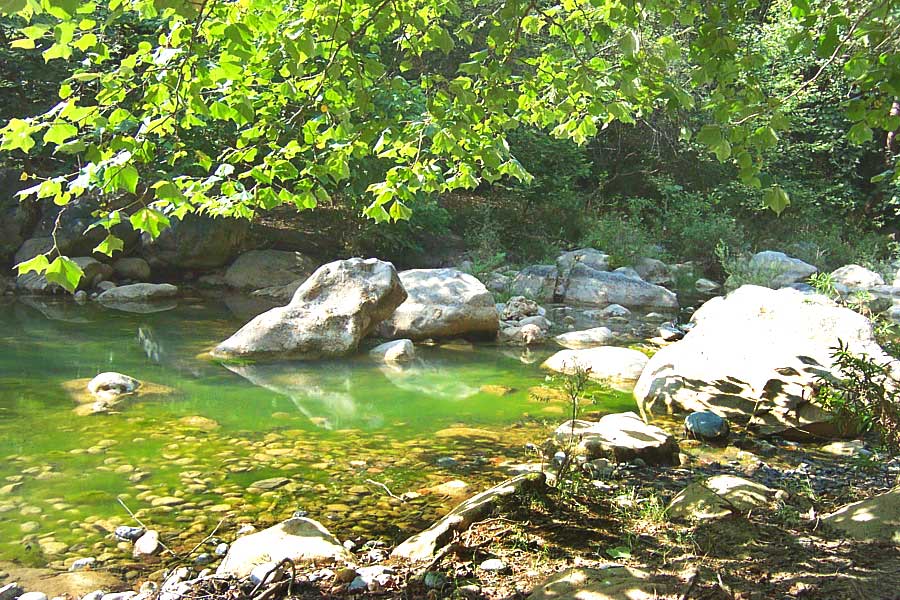
I'd chosen the spot hoping to see wildlife visiting the pool to drink. During the night I'd heard lots of frogs and something knocking rocks about, but that was about it -- except for the sharp, excited-sounding whistles near my tent at dusk the previous day and first thing that morning. The whistles had reminded me of Woodchuck warning calls, so I'd figured it was some kind of mammal with a den in the rocky ledge behind my tent annoyed by my presence.
At the corner of my vision suddenly there was quick movement, a splash, and by the time I'd focused on the action I saw about 30 feet away a large, black hawk carrying something heavy in his talons. Apparently the thing being carried weighed too much to fly far with, for the hawk landed with it at the water's edge. The binoculars told the story: A Common Black Hawk had just plucked something looking like a Giant Toad from the stream.
What a view I had, the tent serving perfectly as a wildlife blind. The hawk was all black except for two conspicuous white bands on his tail, a brightly yellow, curved beak, and exceptionally long, yellow legs. Its whistles were short, agitated-sounding outbursts.
That poor toad! The hawk perched atop it apparently puncturing and repuncturing its body with his talons. Several times a minute, with a brief fluttering of wings, the hawk would jump straight up, raising the toad six inches or so, and I interpreted this as the hawk trying to gain better purchase on his prey, thus probably making new holes in him. After every three to five jumps the hawk would bend forward and cut at the toad with his big, curved beak, sometimes seeming to carve out chunks which he'd swallow. This went on a good 15 minutes.
Up until this time I wasn't 100% sure that the prey was actually a Giant Toad, so now I emerged from the tent and began inching closer. The hawk would have none of this. He flew off, dropping the toad with a heavy plop onto the limestone bed. Reaching the toad and confirming my identification, I was amazed to find him still capable of righting himself and gamely trying to make it to water. When I drew close he took in air, bloating his body considerably. I've read that Giant Toads do this to make themselves too large for certain predators' mouths, but now I wondered whether another advantage might not be to separate the skin from vulnerable organs inside, by lots of air.
The hawk was perched nearby casually with one yellow leg drawn up into his black chest feathers, glaring at me, so I left the scene, hoping I'd not irretrievably disrupted an important moment in the local ecosystem's workings.
By the way, I'd known that Giant Toads occupied the pool next to my tent even before the hawk had snatched one out. The night before many Giant Toads had erupted with their powerfully percussive. At a distance Giant Toads sound like large, idling boat-motors but up close their calls are unbelievably explosive and loud, like the popping, skronking noise made by a hand slipping along a heavily rosined string attached to a large sounding-board.
from the March 17, 2007 Newsletter issued from Sierra Gorda Biosphere Reserve Headquarters in Jalpan, Querétaro, MÉXICO
TADPOLES IN THE RESERVOIR
At dusk and into the night when I step from my little casita, down at the reservoir it almost sounds like hundreds of big, idling boat-motors. It's Giant Toads calling, BUFO MARINAS, also called Cane Toads and Marine Toads.
Nowadays sometimes even at midday you see 15-ft-long, inky, shape-changing blobs slowly migrating through the reservoir's very shallow waters next to shore, like diffuse, black amoebas. The blobs consist of thousands of black, wiggly tadpoles such as those below
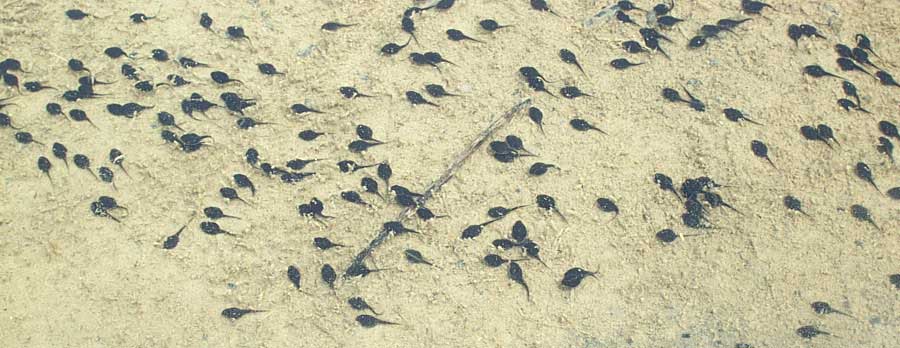
I'm not absolutely sure that the tadpoles in the picture will metamorphose into Giant Toads. However, they certainly were large and they match Giant-Toad tadpole pictures found elsewhere on the Internet.
A large percentage of Giant Toad pictures on the Internet are provided by websites based in Australia. That's because our native Mexican Giant Toads have been introduced there and now they're wrecking havoc on Australian and many other countries' ecosystems.
The first Giant Toads introduced into Australia -- usually there're called Cane Toads there -- were let loose in the hope that they'd eat beetles infesting sugarcane crops. The toads didn't control the beetles but they did begin gulping down many smaller, native Australian organisms.
One problem with Giant Toads is that they're so poisonous that animals who eat them often die. In Australia at least two snake species have responded to the toad's introduction -- which took place only in the 1930s -- by evolving smaller heads. Smaller heads make it less likely that the snakes will eat the Giant Toad and die.